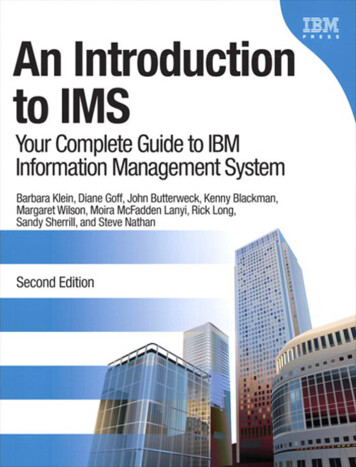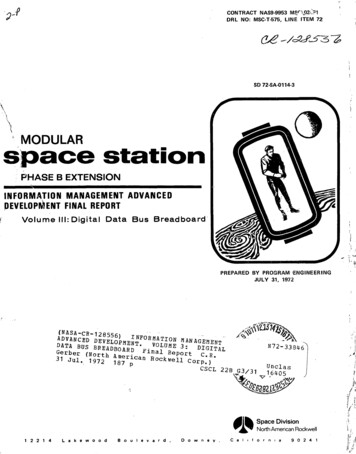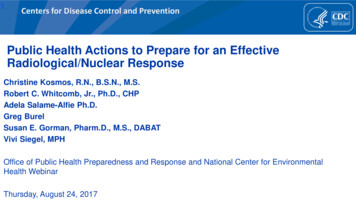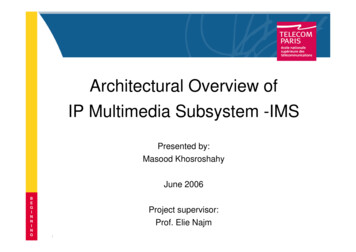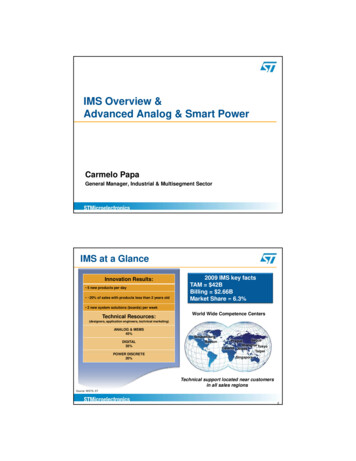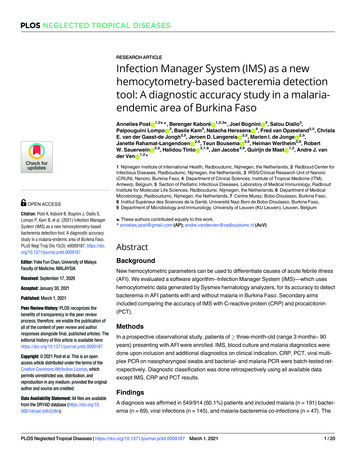
Transcription
RESEARCH ARTICLEInfection Manager System (IMS) as a newhemocytometry-based bacteremia detectiontool: A diagnostic accuracy study in a malariaendemic area of Burkina 111111111OPEN ACCESSCitation: Post A, Kaboré B, Bognini J, Diallo S,Lompo P, Kam B, et al. (2021) Infection ManagerSystem (IMS) as a new hemocytometry-basedbacteremia detection tool: A diagnostic accuracystudy in a malaria-endemic area of Burkina Faso.PLoS Negl Trop Dis 15(3): e0009187. : Yoke Fun Chan, University of MalayaFaculty of Medicine, MALAYSIAReceived: September 17, 2020Accepted: January 30, 2021Published: March 1, 2021Peer Review History: PLOS recognizes thebenefits of transparency in the peer reviewprocess; therefore, we enable the publication ofall of the content of peer review and authorresponses alongside final, published articles. Theeditorial history of this article is available opyright: 2021 Post et al. This is an openaccess article distributed under the terms of theCreative Commons Attribution License, whichpermits unrestricted use, distribution, andreproduction in any medium, provided the originalauthor and source are credited.Data Availability Statement: All files are availablefrom the DRYAD database (https://doi.org/10.5061/dryad.rjdfn2z9m).Annelies Post ID1,2 *, Berenger Kaboré ID1,2,3 , Joel Bognini ID3, Salou Diallo3,Palpouguini Lompo ID3, Basile Kam3, Natacha Herssens ID4, Fred van Opzeeland2,5, ChristaE. van der Gaast-de Jongh2,5, Jeroen D. Langereis ID2,5, Marien I. de Jonge ID2,5,Janette Rahamat-Langendoen ID2,6, Teun Bousema ID2,6, Heiman Wertheim2,6, RobertW. Sauerwein ID2,6, Halidou Tinto ID3,7,8, Jan Jacobs4,9, Quirijn de Mast ID1,2, Andre J. vander Ven ID1,2*1 Nijmegen Institute of International Health, Radboudumc, Nijmegen, the Netherlands, 2 Radboud Center forInfectious Diseases, Radboudumc, Nijmegen, the Netherlands, 3 IRSS/Clinical Research Unit of Nanoro(CRUN), Nanoro, Burkina Faso, 4 Department of Clinical Sciences, Institute of Tropical Medicine (ITM),Antwerp, Belgium, 5 Section of Pediatric Infectious Diseases, Laboratory of Medical Immunology, RadboudInstitute for Molecular Life Sciences, Radboudumc, Nijmegen, the Netherlands, 6 Department of MedicalMicrobiology, Radboudumc, Nijmegen, the Netherlands, 7 Centre Muraz, Bobo-Dioulasso, Burkina Faso,8 Institut Supérieur des Sciences de la Santé, Université Nazi Boni de Bobo-Dioulasso, Burkina Faso,9 Department of Microbiology and Immunology, University of Leuven (KU Leuven), Leuven, Belgium These authors contributed equally to this work.* annelies.post@gmail.com (AP); andre.vanderven@radboudumc.nl (AvV)AbstractBackgroundNew hemocytometric parameters can be used to differentiate causes of acute febrile illness(AFI). We evaluated a software algorithm–Infection Manager System (IMS)—which useshemocytometric data generated by Sysmex hematology analyzers, for its accuracy to detectbacteremia in AFI patients with and without malaria in Burkina Faso. Secondary aimsincluded comparing the accuracy of IMS with C-reactive protein (CRP) and procalcitonin(PCT).MethodsIn a prospective observational study, patients of three-month-old (range 3 months– 90years) presenting with AFI were enrolled. IMS, blood culture and malaria diagnostics weredone upon inclusion and additional diagnostics on clinical indication. CRP, PCT, viral multiplex PCR on nasopharyngeal swabs and bacterial- and malaria PCR were batch-tested retrospectively. Diagnostic classification was done retrospectively using all available dataexcept IMS, CRP and PCT results.FindingsA diagnosis was affirmed in 549/914 (60.1%) patients and included malaria (n 191) bacteremia (n 69), viral infections (n 145), and malaria-bacteremia co-infections (n 47). ThePLOS Neglected Tropical Diseases https://doi.org/10.1371/journal.pntd.0009187 March 1, 20211 / 20
PLOS NEGLECTED TROPICAL DISEASESFunding: AvV and QdM have a non-restrictedresearch grant from SYSMEX corporation Europe,which was used to fund the current study. Sysmexcontributed the prototype XN-450 and requiredreagents for the current study. The funding sourcewas involved in the study design, but not in datacollection, analysis, and interpretation of the data.Competing interests: The authors have declaredthat no competing interests exist.Differentiating causes of fever in the tropics using haemocytometryoverall sensitivity, specificity, and negative predictive value (NPV) of IMS for detection ofbacteremia in patients of 5 years were 97.0% (95% CI: 89.8–99.6), 68.2% (95% CI: 55.6–79.1) and 95.7% (95% CI: 85.5–99.5) respectively, compared to 93.9% (95% CI: 85.2–98.3), 39.4% (95% CI: 27.6–52.2), and 86.7% (95% CI: 69.3–96.2) for CRP at 20mg/L.The sensitivity, specificity and NPV of PCT at 0.5 ng/ml were lower at respectively 72.7%(95% CI: 60.4–83.0), 50.0% (95% CI: 37.4–62.6) and 64.7% (95% CI: 50.1–77.6) The diagnostic accuracy of IMS was lower among malaria cases and patients 5 years but remainedequal to- or higher than the accuracy of CRP.InterpretationIMS is a new diagnostic tool to differentiate causes of AFI. Its high NPV for bacteremia hasthe potential to improve antibiotic dispensing practices in healthcare facilities with hematology analyzers. Future studies are needed to evaluate whether IMS, combined with malariadiagnostics, may be used to rationalize antimicrobial prescription in malaria endemic areas.Trial registrationClinicalTrials.gov (NCT02669823) hor summaryThis study describes the diagnostic accuracy of the Infection Manager System (IMS), anovel diagnostic algorithm for febrile illnesses that is equipped on a routine hematologyanalyzer. The latest generation hematology analyzers allow better differentiation betweenleukocyte subsets and their phenotype. The IMS was created, using differences in immunecell subsets (their activation status for instance), to differentiate viral from bacterial etiologies of fever. Such a tool may guide clinicians in their decision the initiate or withholdantimicrobial therapy.The study was carried out among febrile patients aged 3 months and older in rural Burkina Faso, a sub-Saharan African setting where malaria is endemic. Standard microbiological techniques such as blood culture were used as a reference to assess the diagnosticaccuracy of IMS. We then compared the diagnostic accuracy of the IMS with the marketedbiomarkers C-reactive protein (CRP) and procalcitonin (PCT). Our study showed thatthe diagnostic performance of the IMS was similar to CRP and better than PCT to detectbacteremia in patients with and without malaria co-infection. Further studies are neededto see if the IMS can be safely used to guide initial antimicrobial treatment and help toreduce further spread of antimicrobial resistance.IntroductionAcute febrile illness (AFI) is an important health problem in sub-Saharan Africa (SSA). AFIcan be caused by a variety of pathogens–bacteria, viruses, malaria parasites–which cause anon-specific clinical illness. Establishing the microbiological origin of AFI without laboratorydiagnostics remains a challenge. While malaria remains common, there is an increasing appreciation for non-malarial causes of AFI in SSA [1,2] as well as for concurrent malaria andPLOS Neglected Tropical Diseases https://doi.org/10.1371/journal.pntd.0009187 March 1, 20212 / 20
PLOS NEGLECTED TROPICAL DISEASESDifferentiating causes of fever in the tropics using haemocytometrybacteraemia [3–5]. The mortality of bacteremia is high and the prognosis depends on early recognition and treatment.The introduction of malaria rapid diagnostic tests (RDTs) has greatly rationalized the use ofanti-malarial drugs. However, other diagnostic tools for evaluation of AFI such as bacterialculture, are rarely available in SSA. Antibiotics are therefore regularly prescribed empiricallyamong patients presenting with undifferentiated AFI. Even when malaria is suspected, antibiotics are commonly administered because of fear for concurring bacteremia [6]. The lack ofmicrobiological tests indicating a bacterial infection is fueling antibiotic overuse and development of antimicrobial resistance (AMR) [7]. The global increase in AMR has been decreed animminent threat to global health by the World Health Organization (WHO). As a result, development of rapid diagnostics for differentiation between bacterial- and non-bacterial AFI hasbecome a priority [8].An alternative to pathogen-specific (microbiological) diagnostics is to assess the hostimmune response to pathogens in peripheral blood. Biomarkers such as C-reactive protein(CRP) or procalcitonin (PCT) are advocated to guide antibiotic prescription, but their usefulness for patients with a concurrent malaria infection has been scarcely studied [9,10]. The hostimmune response can also be assessed by evaluating blood-cell morphology using hemocytometry. The latest generation Sysmex automated cell counters (hematology analyzers) areequipped with an enhanced panel of parameters detailing blood-cell differentiation, which wasused to create a software algorithm–Infection Manager System (IMS)–to differentiate causesof AFI. The IMS has previously been tested in Indonesia, demonstrating its capacity to differentiate between arboviral and bacterial infection among adults[11]. Here we describe the diagnostic accuracy of the IMS to detect bacteremia and other bacterial infections in patients withAFI in a malaria endemic area in Burkina Faso, with reference to standard microbiologicaland clinical diagnostics, and compared to CRP and PCT.MethodsEthics statementThe study was performed in accordance with the declaration of Helsinki. The study wasapproved by the national ethical committee of Burkina Faso (ref 2015-01-006), the internalreview board of IRSS (ref A03-2016/CEIRES) the ethical committee of the Antwerp UniversityHospital (ref 15/47/492) and the institutional review board of the Institute of Tropical Medicine Antwerp (ref 1029/15). Written informed consent was obtained from all participants ortheir parents/legal guardians prior to their inclusion.Study designWe performed a diagnostic accuracy study (clinicalTrials.gov, NCT02669823) at the ClinicalResearch Unit of Nanoro (CRUN) designed to assess the accuracy of two new Sysmex technologies: (1) a prototype hematology analyzer (XN-30) to directly detect malaria parasitized erythrocytes and (2) a marketed XN-450 hematology analyzer equipped with the IMS algorithm.This manuscript only includes the results obtained with the XN-450 hematology analyzerequipped with the IMS prototype. The performance of XN-30 has been published elsewhere[12].The primary aim of the present study was to assess the diagnostic accuracy of the IMS fordetecting bacteremia and malaria-bacteremia co-infection in a malaria endemic area amongparticipants of five years and older. Secondary aims were to assess the diagnostic accuracy ofthe IMS for detection of (i) bacteremia among children five years, (ii) bacterial infections,PLOS Neglected Tropical Diseases https://doi.org/10.1371/journal.pntd.0009187 March 1, 20213 / 20
PLOS NEGLECTED TROPICAL DISEASESDifferentiating causes of fever in the tropics using haemocytometryand (iii) viral infections among both patients (i.e., below and 5 years old) as well as (iv) comparison of the diagnostic accuracy of the IMS to detect bacteremia with that of CRP and PCT.Study population and proceduresThe Nanoro area in Burkina Faso [13] is hyperendemic for Plasmodium falciparum infectionswith peak incidences coinciding with the rainy season (July-October) [14]. Bacteremiaamong five year old children is predominantly caused by non-Typhoidal Salmonella [15,16].Participants were enrolled between March 2016 and June 2017 at the district hospital “CentreMedical avec Antenne Chirurgicale” (CMA) Saint Camille de Nanoro to which CRUN is affiliated [14]. Patients of three months and older with suspected AFI needing hospitalization werescreened for eligibility. Patients were eligible if they had a measured temperature (auricular) of 38.0 C or 35.5 C, or a reported history of fever up to 48 hours prior to presentation, andsuspicion of severe infection with signs of severe clinical illness including respiratory distress,prostration, altered consciousness, convulsions (one or more episodes), clinical jaundice, Systemic Inflammatory Response Symptoms (SIRS) criteria, severe malnutrition with severe anemia (hemoglobin 5 g/dl). Patients with fever lasting more than 7 days were excluded.Upon inclusion, 2–5 ml EDTA anticoagulated blood was sampled for the index test, complete blood count, malaria diagnostics (thick- and thin blood films and RDTs) and blood culture. All samples were processed within one hour after sampling. A nasopharyngeal swab andaliquots of residual blood and plasma were stored at -80 for retrospective analyses. Additionaldiagnostics such as chest X-ray (CXR), abdominal echography, urinalysis, and culture of urine,stool, pus, or cerebrospinal fluid were performed on indication. Patients were followed dailyduring hospitalization and follow-up samples were taken if clinically indicated. Procedures forthe reference tests used to diagnose the various underlying diseases are described in S1 Text.Diagnostic classification was independently done by two study doctors (BK and AP) and aninfectious disease specialist (QdM) after inclusion had been completed. In case of discordantresults (10%), QdM assigned the decisive diagnosis. AP, BK and QdM used all available information except for CRP, PCT and IMS results. All cases were subjected to a “diagnostic classification”, referring to the final diagnosis assigned by the researchers which therefore includescases with uncertain etiology. The term “confirmed diagnosis” refers to any case in which theetiology of disease was confirmed through clinical signs (e.g., erysipelas), or microbiological/radiological confirmation. The diagnostic classification scheme is described in S1 Table. Coinfections were defined as the presence of two or more confirmed infections. Newly diagnosedtuberculosis cases were considered bacterial infections. Newly diagnosed HIV infections wereconsidered infection of unknown origin. Patients with HIV and a confirmed co-infection wereclassified according to the co-infection.Index test: Infection Manager SystemThe XN-series hematology analyzers (Sysmex Corporation, Kobe, Japan) can distinguish activated from non-activated cells by quantifying cellular activity and cell-membrane compositionusing fluorescence- and surfactant reagents that target RNA, DNA and bioactive lipid rafts[17]. This leads to further differentiation of cell lineages (see also S2 Table). The resultingenhanced panel of parameters detailing blood cell differentiation [17–21] was used to create analgorithm–the IMS—a software update that provides flags indicating presence or absence ofan inflammatory response and subsequently classify the inflammation as matching malaria,bacterial or viral infection [18]. The output comprises a complete blood count (CBC) in combination with a flag and calculated likelihood score for viral and bacterial infections, see alsoS2 Text. The IMS reports ‘Inflammation of unknown origin’ when inflammation is flaggedPLOS Neglected Tropical Diseases https://doi.org/10.1371/journal.pntd.0009187 March 1, 20214 / 20
PLOS NEGLECTED TROPICAL DISEASESDifferentiating causes of fever in the tropics using haemocytometrybut none of the likelihood scores match a decisive etiology. Data on performance of themalaria score are premature as the malaria score is still in early development. This manuscriptreports the number of cases flagged as malaria or malaria co-infection but does not analyze itsperformance against malaria diagnostics.The IMS algorithm was originally designed for adults [11]. To account for the rapid changesin blood composition during infancy, as well as differences in immunological response topathogens between young infants and adults, the algorithm was converted to use absolutenumbers of cell subsets rather than percentages. The main text reports the results of the converted algorithm, results of the original algorithm as tested in Indonesia are presented in S3Table.Healthy control samplesA concurrent explorative cross-sectional field study to assess baseline hemocytometry dataamong a healthy population of one year and older was performed in the same study area (ClinicalTrials.gov Identifier: NCT03176719). Details on primary objectives will be reported elsewhere. A secondary objective was to assess the prevalence of subclinical malaria infections inthe area. The blood samples were analyzed to assess how frequently IMS flagging inflammationwas found among a healthy population with and without malaria parasitemia. Results werecompared with plasma CRP levels.Statistical analysisData analysis was done according to a statistical plan agreed upon before data inspection. Datawas analyzed using Stata 14 (Stata Corp, College Station, TX, USA). Differences in proportionsand medians were compared using as appropriate a chi-square test, Mann-Whitney-U test, orstudent’s t-test. Patients without a confirmed diagnosis were excluded from analysis. Sensitivity, specificity, positive predictive value (PPV) and negative predictive value (NPV) wereassessed using the diagt-package (Stata). Cut-off values for CRP and PCT were defined priorto data inspection. Two cut-off values were used to predict a bacterial etiology of fever (1) 20mg/L and 0.5 ng/ml plasma respectively as previously proposed in literature [22] and (2) theoptimal cut-off value as determined by ROC analysis. Comparative analyses of diagnosticaccuracy between the IMS and CRP/PCT were done using a McNemar test and reported astest-ratios with significance level. A significance level of 5% was used for all analyses.ResultsA total of 930 patients (age ranged 3 months– 90 years old) were included between March2016 and July 2017, sixteen of whom were subsequently excluded because of missing clinicaldata or IMS results, leaving 914 patients for analysis (Fig 1). Patients were subdivided into twoage groups– five years (n 449) and five years (n 465)–to account for age-related differences in blood composition and immune response. Table 1 shows baseline characteristics anddiagnostic classification for both age groups. The percentage of antimalarials taken in the pasttwo weeks was higher among patients below five years (38.3% versus 28.8%; p .002) whereasthe number of patients who had taken antibiotics in the past two weeks was similar (39.6% vs39.4%; p .9).In 343/449 (76.4%) patients below five years and in 206/465 (44.3%) patients of five yearsand older, a diagnosis was confirmed using pre-defined case definitions (Table 1). The pathogens causing bacteremia with (n 47) and without (n 69) concurrent malaria parasitemiaare specified in Table 2. In total 191 patients had clinical malaria and an additional 12 malariapatients had a concurrent viral (n 4) or non-bacteremic bacterial (n 8) co-infection.PLOS Neglected Tropical Diseases https://doi.org/10.1371/journal.pntd.0009187 March 1, 20215 / 20
PLOS NEGLECTED TROPICAL DISEASESDifferentiating causes of fever in the tropics using haemocytometryFig 1. Flow chart of 9187.g001The IMS flagged inflammation matching bacterial infection in 318/914 (34.8%) (whichincludes both bacteremia and non-bacteremic bacterial infection), viral infection in 239/914(26.1%) and malaria in 86/914 (9.4%) cases. In 50/914 (5.5%) patients the IMS found inflammation matching a combined malaria-bacterial infection. Inflammation of unknown originwas flagged in 221/914 (24.2%) patients consisting of 121 (54.8%) cases without- and 100(45.2%) with a confirmed diagnosis (e.g., malaria (n 46), viral infections (n 27) bacterialinfections (n 22, including one bacteremia), and combined malaria-bacterial (n 4) ormalaria-viral (n 1) infections).Diagnostic accuracy of the IMS for detection of bacteremia with and without concurringmalaria parasitemia.Fig 2 provides an overview of the diagnostic accuracy of the IMS to detect bacteremia byage group. The overall sensitivity of the IMS for detection of bacteremia was 92.2% (CI 95%85.8–96.4) with a specificity of 70.9% (CI 95% 65.8–75.6), a PPV of 51.2% (CI 95% 44.2–58.2)and a NPV of 96.5% (CI 95% 93.5–98.4) among patients of all ages, with and without concurrent malaria parasitemia (Table 3). The sensitivity among five years old patients was higherthan those five years of age (97.1% [CI 95% 89.8–99.6] versus 85.4% [CI 95% 72.2–93.9];p 0.0001), while the latter had a higher specificity (71.7% [CI 95% 66.1–76.9] versus 67.2%[CI 95% 54.6–78.2]; p .0001). Concurrent malaria parasitemia decreased the accuracy toPLOS Neglected Tropical Diseases https://doi.org/10.1371/journal.pntd.0009187 March 1, 20216 / 20
PLOS NEGLECTED TROPICAL DISEASESDifferentiating causes of fever in the tropics using haemocytometryTable 1. Baseline characteristics and diagnostic classification by age group (n 914).Median (interquartile range (IQR)Less than 5 years5 years and oldern 449n 46518.8 (10.5–32.0)30 (13–52) 1 years old (n [%])146 (32.5)-1–5 years old (n [%])303 (67.5)-5–15 years old (n [%])-127 (27.3) 15 years old (n [%])-338 (72.7)Male: Female ratio1.511.26Median age in months ( 5 years) or years ( 5 years)Temperature at presentation ( C)38.4 (38.0–39.4)38.3 (37.9–39.0)Days of fever before presentation (days)2 (2–3)3 (2–4)Antimalarials in past 2 weeks (n [%])172 (38.3)134 (28.8)Antibiotics in past 2 weeks (n [%])178 (39.6)183 (39.4)Systolic blood pressure (mm/Hg)98 (89–108)106 (96–120)Diastolic blood pressure (mm/Hg)61 (55–67)66 (60–76)Pulse (per min)124 (110–134)107 (98–122)Respiratory rate (per min)34 (32–40)27 (26–29)Malnutrition (n [%]) 187 (41.6)133 (28.6)90 (20.0)32 (6.9)Severe Acute Malnutrition (n [%])Current HIV at inclusion2 (0.5)14 (3.0)Current Tuberculosis treatment06 (1.29)Biologically, clinically, or radiologically confirmed diagnoses(n 343/449, 76.4%)(n 206/465, 44.3%)Malaria 143 (41.7%)48 (23.3%)Bacteremia without malaria co-infection20 (5.8%49 (23.7%)Bacteremia with malaria co-infection28 (8.2%)19 (9.2%)Other bacterial infections6 (1.7%)66 (32.0%)Meningitis02Urinary tract infection06Gastroenteritis21Clinical diagnoses227Pneumonia214Tuberculosis016Diagnostic classification by age groupViral infection138 (40.0%)17 (8.3%)Respiratory tract infection 13815Hepatitis02Malaria-bacterial infection3 (0.9%)5 (2.4%)Malaria-viral infection2 (0.6%)2 (0.9%)Bacterial-viral infection3 (0.9%)0 (0.0%)Uncertain etiology of disease(n 106/449, 23.6%)(n 259/465, 55.7%)Infection of unknown origin87 (82.1%)143 (55.2%)Suspected bacterial infection1061Suspected viral infection01Malaria with suspected other infection914Newly diagnosed HIV without bacteremia019Others68484 (3.8%)55 (21.2%)Non-infectious diagnosis(Continued )PLOS Neglected Tropical Diseases https://doi.org/10.1371/journal.pntd.0009187 March 1, 20217 / 20
PLOS NEGLECTED TROPICAL DISEASESDifferentiating causes of fever in the tropics using haemocytometryTable 1. (Continued)Median (interquartile range (IQR)Diagnosis unknown Less than 5 years5 years and oldern 449n 46515 (14.2%)61 (23.6%)For children 5 years a Z-score weight/height of -2 or lower, for patients 5 years and older BMI z-score -2wasused. Severe Acute Malnutrition was defined as a Z-score weight/height of -3 or lower among children 5 years or aBMI z-score of -3Reports only the cause of illness. In total 137 cases of qPCR confirmed submicroscopic malaria with parasite densities ranging from 0.007 to 13.7 were not included in this overview. PCR on nasopharyngeal swab only performed for patients 15 years 01detect bacteremia in both age groups; with a sensitivity of 90.0% (CI 95% 68.3–98.8) versus82.1% (CI 95% 63.1–93.9) in patients 5 years old (p .0001) and 98.0% (CI 95% 89.1–99.9)versus 94.7% (CI 95% 74.0–99.9) among patients of 5 years and older (p .0001).There were a number of cases in which the IMS flagging for bacteremia was false negativeand in which IMS flagging for bacterial infection was false positive (Table 4). Since the IMScannot differentiate bacteremia from bacterial infections, a false-positivity rate for bacteremiaalone cannot be calculated. In total 9/116 (7.7%) confirmed bacteremia cases were flagged aseither viral infection (n 6), malaria (n 2) or infection of unknown origin (n 1). Themajority (n 5) were invasive non-Typhoidal Salmonella (iNTS) cases among children belowfive years. Eight were blood culture confirmed, one was Polymerase Chain-Reaction (PCR)confirmed. In three cases antibiotics had been taken prior to inclusion to the study.In total 103 non-bacterial cases were flagged as bacterial; they comprised patients withmalaria (n 64), viral respiratory tract infection (n 37), and one patient each with viral hepatitis and combined malaria/viral infection.Table 2. Overview of pathogens causing bacteremia in those with- and without concurrent malaria parasitemia (n 116).All bacteremia casesBacteremia without concurrentparasitemiaBacteremia with concurrent parasitemiaLess than 5 years5 years and olderLess than 5 years5 years and olderLess than 5 years5 years and oldern 48n 68n 20n 49n 28n 19124Salmonella spp26137919Escherichia coli21721403Neisseria meningitidis211110Haemophilus influenzae33742512Staphylococcus aureus0750502Streptococcus pneumoniae12617761166Other Gram-negatives130211Other Gram-positives121200Mixed infection81110011. 2/26 (7.7%) cases PCR confirmed 2. 4/13 (30.8%) cases PCR confirmed 3. 1/3 (33.3%) cases PCR confirmed 4. 7/7 (100%) cases PCR confirmed 5. 2/7 (28.6%)PCR confirmed 6. 6/12 (50.0%) PCR confirmed 7. 7/17 (41.2%) PCR confirmed. In total n 29 (25.0%) were PCR confirmed, the rest (n 87; 75.0%) were bloodculture confirmed 8. Mixed infections constituted blood cultures yielding more than one 187.t002PLOS Neglected Tropical Diseases https://doi.org/10.1371/journal.pntd.0009187 March 1, 20218 / 20
PLOS NEGLECTED TROPICAL DISEASESDifferentiating causes of fever in the tropics using haemocytometryFig 2. Diagnostic accuracy of the IMS for bacteremia by age group. Legend: IMS: Infection Manager System “Reference”refers to blood culture confirmed .g002Comparison with CRP and PCTCRP and PCT plasma levels were available for 883/914 (96.6%) patients. Among the differentinfections, median CRP levels of both bacteremia cases (107, IQR 44–142, n 65) and all confirmed bacterial infections without malaria co-infection (97 mg/L, IQR 47–134; n 109) weresignificantly higher than those obtained from clinical malaria cases (51 mg/L, IQR 22–100,n 180; p .0001 in both analyses). Samples of viral infections recorded the lowest CRP values (8 mg/L, IQR 3–23, n 126).Median PCT levels were highest among patients with malaria (3.5 ng/ml, IQR 0.6–18.2,n 180) compared to patients with bacteremia- (1.9 mg/ml, IQR 0.5–8.5, n 65), confirmedbacterial infections without malaria co-infection (0.9 ng/ml, IQR 0.4–3.9, n 109), and viralinfections (0.47 ng/ml, IQR 0.22–1.39). An overview of CRP and PCT values among the various types of infections can be found in S1 Fig.The median (IQR) of CRP and PCT levels among patients with malaria, different causes ofbacteremia (Salmonella, other Gram-negative and Gram-positive infections), and malaria-bacteremia co-infections is presented in Fig 3A and 3B. Malaria with bacterial co-infection produced slightly, though not significantly (p 0.07) higher CRP plasma levels (72 mg/L, IQR 34–107, n 43) compared to malaria alone (51 mg/L, IQR 22–100, n 180), with considerableoverlap between the two (Fig 3A). We found a wide spread of CRP levels between variouscauses of bacteremia (Fig 3B), with Gram-negative causes of bacteremia (e.g., Salmonella) having significantly lower CRP levels compared to Gram-positive causes of bacteremia (p 0.02).To compare the accuracy of the IMS to detect bacteremia with CRP and PCT, we performed a sub-analysis to the analysis performed in Table 3, using only patients with availableCRP and PCT data (n 445). This meant excluding a further 21 patients in whom insufficientplasma was available for CRP and PCT analysis (Table 5). At cut-off values of respectively 20mg/L (CRP) and 0.5 ng/ml (PCT), the diagnostic accuracy of the IMS outperformed bothPLOS Neglected Tropical Diseases https://doi.org/10.1371/journal.pntd.0009187 March 1, 20219 / 20
PLOS NEGLECTED TROPICAL DISEASESDifferentiating causes of fever in the tropics using haemocytometryTable 3. Diagnostic accuracy of the IMS for bacterial bloodstream infections presented by age group for patients with- and without malaria parasitemia (qPCR 0.05 p/uL). The reference value is presented on the rows, the IMS result is presented in the columns.IMS indicatesbacterialIMS indicates nonbacterialIMS indicatesbacterialIMS indicates nonbacterialIMS indicatesbacterialIMS indicates nonbacterialBacteremia among all cases (n 466)Culture confirmedbacteremiaLess than five years (n 331)Five years and older (n 135)All ages combined (n 466)41766210792032245102248Non-bacterial infection80Sensitivity (% [CI 95%])85.4 (72.2–93.9)97.1 (89.8–99.6)92.2 (85.8–96.4)Specificity (% [CI 95%])71.7 (66.1–76.9)67.2 (54.6–78.2)70.9 (65.8–75.6)PPV (% [CI 95%])33.9 (25.5–43.0)75.0 (64.6–83.6)51.2 (44.2–58.2)NPV (% [CI 95%])96.7 (93.3–98.6)95.7 (85.5–99.5)96.5 (93.5–98.4)AUC (CI 95%)0.79 ((0.73–0.84)0.82 (0.76–0.88)0.82 (0.78–0.85)Bacteremia among malaria negat
(AFI). We evaluated a software algorithm-Infection Manager System (IMS)—which uses hemocytometric data generated by Sysmex hematology analyzers, for its accuracy to detect bacteremia in AFI patients with and without malaria in Burkina Faso. Secondary aims included comparing the accuracy of IMS with C-reactive protein (CRP) and procalcitonin .
